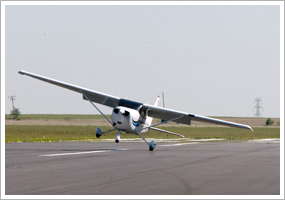| The following stories from the November 27, 2009, edition of AOPA ePilot were provided to AOPA members who expressed an interest in the particular subject areas. Any AOPA member can receive information tailored to their areas of interest by updating their preferences online.
TRAINING TIPsCrosswind confidence
Don’t delay remedying that problem! “The truth is, it really doesn't matter what size airplane you're flying, crosswind technique is crosswind technique. Pilots who don't learn how to cope with crosswinds early on never seem to learn to cope with them—that's why it's so important to learn now,” wrote Christopher L. Parker in the April 2006 AOPA Flight Training feature “ Crosswind Tutorial.” See his four steps to performing better crosswind landings.
And here’s a tip for keeping tabs on your crosswind work: Be sure to record, or have your flight instructor record in your training documentation, the winds—speed and direction—in which you have practiced on dual and solo flights. That way you’ll preserve the details of how much crosswind you have handled and how it felt. If winds were gusty or variable, write it down, and then evaluate its effects on that day’s session.
Suppose you’re landing on Runway 9 in winds from 140 at 25 knots. What’s the crosswind component of those values? The headwind component? Being able to estimate crosswind component is helpful when you tune in the ATIS broadcast and hear the winds and weather while inbound for landing. Estimating will be easier if you have practiced making calculations during ground training sessions. How to calculate crosswind and headwind components (and answers to the questions above) is given in “ AOPA’s Handbook for Pilots.”
As discussed in the Nov. 20 “ Training Tip: Say request,” sometimes a pilot may want to ask air traffic control for an alternate plan of action. If more than one runway is available at a tower-controlled airport, don’t hesitate to request to use the runway best aligned with the wind if conditions are difficult.
Confidence comes from practice; caution comes from knowing your limits. TRAINING PRODUCTSConnect with other pilots on SocialAviation.comLooking for a new place to connect with other pilots? Social Aviation offers a Facebook-like interface for creating a profile, storing back-up flight logs, posting and sharing photos, and meeting like-minded people. Privacy settings allow you to establish a profile anyone can see, or only invited friends, or just you. The service is free.
Note: Products listed have not been evaluated by ePilot editors unless otherwise noted. AOPA assumes no responsibility for products or services listed or for claims or actions by manufacturers or vendors. FINAL EXAMQuestion: I am very interested in a career in aviation, but I am not interested in flying for the major airlines. Does AOPA have any resources that provide information about flying careers other than the airlines?
Answer: There are dozens of professional flying opportunities besides the airlines. AOPA’s subject report, Flying Careers, profiles many different career options and provides information on how to get started.
Got a question for our technical services staff? E-mail [email protected] or call the Pilot Information Center, 800/872-2672. Don’t forget the online archive of "Final Exam" questions and answers, searchable by keyword or topic. |
 One topic always sure to get a conversation going among pilots is crosswinds and how to take off and land in them—especially land. Crosswinds are as variable in nature as the weather itself, so be sure that your practical training delves deeply into the subject. Many pilots confess lack of confidence in their crosswind technique, or feel that they didn’t get enough exposure to serious crosswinds as student pilots. (See such a discussion in the
One topic always sure to get a conversation going among pilots is crosswinds and how to take off and land in them—especially land. Crosswinds are as variable in nature as the weather itself, so be sure that your practical training delves deeply into the subject. Many pilots confess lack of confidence in their crosswind technique, or feel that they didn’t get enough exposure to serious crosswinds as student pilots. (See such a discussion in the 

